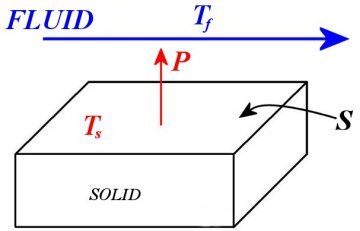www.leguman.ht.st
| head losses |
pumps |
convection |
| Conduction + Convection |
| Wb effect on the fluid flow |
| Radiation |
©
2001 - 2002.
|
| previous | ||
|
Goodbye Fourier, hello Newton
It is roughly the same equation as for Fourier's Law but some ingredients
have changed. Newton's Law gives a proportionality
relationship between on the one hand the thermal power P
given by the solid to the fluid and on the other hand the difference
between surface temperature Ts of the solid (the plate which conveyed the heat
up to here) and the temperature Tf
of the fluid, as well as the area S
depending on the fluid-surface contact.
Generally, surface and fluid temperature vary according to where we're looking at, so it is appropriate to specify what is understood by temperature. In this relation, they are generally defined in the following way :
We now can express the thermal resistance associated with convection : What consequences can we draw from this expression ? Well, we always
seek to make it as low as possible. Obviously it is desired to have
a high convective transfer coefficient and a large surface area.
Concerning the surface area, nothing special except that we will
see later how to increase it with fins. Concerning the convective
transfer coefficient, things become complicated !
|
||
| previous |

